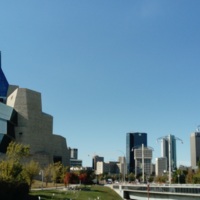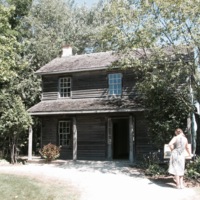
Canadian Museum for Human Rights
Situated in Winnipeg, at the heart of the Canadian Prairies, the Canadian Museum for Human Rights is the first museum in the world solely dedicated to the past, present and future of human rights. The museum aims to create inspiring interactive experiences for its visitors in order to equip them with the tools needed to make a difference in the lives of others. It is the first museum in nearly five decades to be built outside Canada's National Capital Region, with funding from the Canadian government, after being established by legislative amendments to the Museums Act in 2008. The museum's building was purpose-built, designed to reflect the themes of the museum in the external construction, with a Hall of Hope built in luminous alabaster and outside glass wings surrounding the building represent a dove as a symbol of peace.
The Canadian Museum for Human Rights has ten core galleries as well as two spaces for temporary or travelling exhibitions. All of the displays within the museum feature diverse aspects of human rights. These include: a discursive introductory display about what human rights are, a gallery that explores the perspectives of indigenous Canadian people, and an exhibition that focusses on the stories of Canadian individuals or groups that have had their own 'journeys' with human rights challenges. Another exhibition features an overview of Canada's legal stance on human rights. Other galleries explore human rights from a more global perspective, looking at the Holocaust, other instances of genocide around the world and 'Turning Points' that have marked key changes in international human rights policy. The later galleries on the visitor route explore human rights in the present and their potential in the future, challenging visitors to take action and inspire change. All of these galleries feature the use of digital interactives, film and audio presented from lots of different perspectives, often providing the visitor an opportunity to actively participate with the theme of the exhibition. Built without a collection, the museum has filled its galleries with objects on loan from organisations around the world, both in Canada and abroad. They also have objects donated to them from the people and groups the galleries represent. The museum also has a Tower of Hope that visitors can go up, with views over the city, and an indoor garden of reflection.
The Transatlantic Slave Trade is cited as the first instance of genocide in world history in the 'Breaking the Silence' gallery which explores the role of secrecy and denial in the persecution of genocide and what happened when people spoke out or offered resistance. The centre-piece of the gallery is an interactive table that shows instances of genocide, both through time and across the world, alongside related documents and images. The 'Canadian Journeys' gallery incorporates the narrative of enslaved Africans using the Underground Railroad to escape to freedom in Canada. There are also narratives of more contemporary forms of slavery and human trafficking. Narratives of enslavement have also featured in public programmes at the museum.

Uncle Tom’s Cabin Historic Site
Built on the site of the Black settlement that Rev. Josiah Henson helped found in 1841, Uncle Tom’s Cabin Historic Site preserves the settlement where Henson and his wife Nancy lived. The site is situated within 200 acres and was named after Harriet Beecher Stowe’s popular 1852 antislavery novel which featured an enslaved African man named Tom (based on Josiah Henson) as its protagonist. The area of land was purchased in 1841 to establish the Dawn Settlement - a refuge for the many fugitives from slavery who escaped to Canada from the USA. Today thousands of visitors travel to the site every year to learn and understand more about this history. The site includes a number of buildings which originally composed the British-American Institute, an all-ages teacher training and general education manual school. Present day visitors will find examples of a sawmill, smokehouse, and pioneer church, as well as the Henson family cemetery. The house where Josiah Henson and his wife Nancy lived has also been restored to 1850s period fashion. Also located on the site is the Josiah Henson Interpretive Centre which houses a collection of 19th century artefacts relating to the abolitionist era and to Henson himself. Highlights include a rare early edition of Henson’s autobiography and a signed portrait of Queen Victoria presented to him in 1877. Upon arrival at the Interpretive Centre, visitors are guided into the North Star Theatre where they are shown a film titled Father Henson: His Spirit Lives On. A further gallery named Underground Railroad Freedom Gallery displays a narrative of the history of African freedom seekers from initial capture in Africa and enslavement in the United States to freedom in Canada. The site also runs a variety of educational programmes aimed at children and young adults, alongside a popular programme of guided tours.